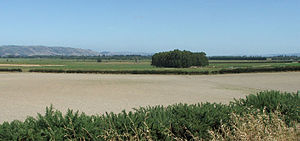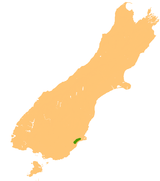| Revision as of 19:59, 27 February 2017 editGothicchicken (talk | contribs)75 edits Edited "deer is" to "deer farming is" to match subject with verb. One could also use "deer are".← Previous edit | Revision as of 19:41, 2 May 2018 edit undoAmbrosia10 (talk | contribs)Autopatrolled, Extended confirmed users34,643 edits Adding reference section in preparation for referencesNext edit → | ||
| Line 13: | Line 13: | ||
| To the southwest, a short stretch of rolling hill country separates the Taieri Plain from ]'s other main lowland areas around the ] and ]. The twin lakes of ] and ] sit within these hills. | To the southwest, a short stretch of rolling hill country separates the Taieri Plain from ]'s other main lowland areas around the ] and ]. The twin lakes of ] and ] sit within these hills. | ||
| ==References== | |||
| {{Reflist}} | |||
| ==Further reading== | ==Further reading== | ||
Revision as of 19:41, 2 May 2018
| This article does not cite any sources. Please help improve this article by adding citations to reliable sources. Unsourced material may be challenged and removed. Find sources: "Taieri Plain" – news · newspapers · books · scholar · JSTOR (December 2009) (Learn how and when to remove this message) |




The Taieri Plain (also referred to in the plural as the Taieri Plains) are an area of fertile agricultural land to the southwest of Dunedin, in Otago, New Zealand. The plain covers an area of some 300 square kilometres, with a maximum extent of 30 kilometres.
The floodplain of the Taieri and Waipori Rivers, the plain is enclosed to the west by the Maungatua and Silverpeaks Ranges, and to the south and east by a low range of coastal hills.
Dairy and sheep farming dominate the agriculture of the plain, although deer farming is starting to have an economic impact. The alluvial nature of the land means that floods are not uncommon, especially in the area around the confluence of the two rivers. Stopbanks protect farmland, houses and Dunedin International Airport at Momona. State Highway 1 crosses parts of the plain along some of the stopbanks, with the result that this stretch of road is known locally as The "floodfree" highway.
New Zealand's lowest point, at 2m below sea level, is slightly north of the airport on Kirks Drain Road.
To the northeast, the city of Dunedin is separated from the Taieri Plain by a range of rugged hills which are part of the crater of an extinct volcano. At the northeastern limit of the plain lies the town of Mosgiel, officially part of the city of Dunedin. Other settlements and towns on the plain include Outram, Henley, Allanton, and Momona.
To the southwest, a short stretch of rolling hill country separates the Taieri Plain from South Otago's other main lowland areas around the Tokomairaro River and Clutha River. The twin lakes of Waihola and Waipori sit within these hills.
References
Further reading
- Shaw, M. S., and Farrant, E. D. (1949) The Taieri Plain: Tales of years that are gone. Dunedin: Otago Centennial Historical Publications.
45°53′S 170°14′E / 45.89°S 170.24°E / -45.89; 170.24
Categories: